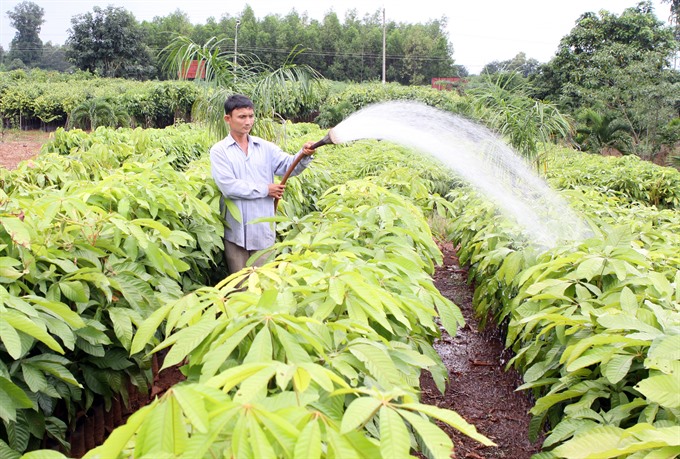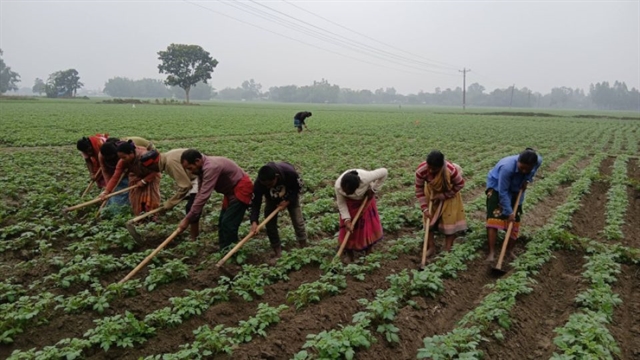 Environment
Environment

The Communist Party and the government of Việt Nam have for long realised that climate change and its devastating consequences are not just a scientific forecast but already a reality and they are aware one of the country’s key tasks is to protect its natural forests.
 |
| Seedlings are being cared for prior to being replanted within the reforestation scheme done in Đồng Nai Culture and Nature Reserve in the southern province of Đồng Nai. — VNA/VNS Photo Quang QUyết |
HÀ NỘI — The Communist Party and the government of Việt Nam have for long realised that climate change and its devastating consequences are not just a scientific forecast but already a reality and they are aware one of the country’s key tasks is to protect its natural forests.
Commitment to this task was evidenced by last year’s official order "closing down natural forest," effectively barring the use of natural forest land for other purposes, and attempts to sustainably utilise resources from natural forests were promoted.
A statement on this was made by Cao Đức Phát, permanent vice-head of the Party Central Committee’s Commission for Economic Affairs, at a high-level forum on realising opportunities for sustainable natural forest management held on Monday in Hà Nội.
The event was organised by the Ministry of Agriculture and Rural Development, UN-REDD Việt Nam and the Norwegian Ministry of Climate and Environment. Representatives from various government agencies, international partners and the private sector participated in the event to ensure a broad-based dialogue.
Việt Nam ranks 33rd globally in terms of natural resources, but is comparatively poor in turning those assets into economic opportunities. Việt Nam has been a leader in experimenting redistribution mechanisms like payment for forest environmental services (PFES), which is expected to reach and redirect $100 million annually from 2017 onwards, however, there are rooms for improvement, as the current rate of $15 per ha of forest is quite low compared to leading countries like Costa-Rica’s PFES $60 per ha or India’s budget devolution mechanism’s rate of $120.
Tim Boyle, UN co-ordinator for UN-REDD Asia Pacific Region, lamented upon the fact that the value of forest land had not been fully calculated by the national accounting system, as forests accounted for only one per cent of the total national GDP in 2010, while other critical benefits from forests – providing protection for watershed, biodiversity conservation, and ecotourism – had not been accounted for in the GDP.
Nguyễn Văn Hà, deputy head of the Việt Nam Administration of Forest (MARD), said national forest coverage had jumped from 33.3 per cent in 2010 to 44.19 per cent in 2016.
However, the forestry bureau also said the maximum coverage that Việt Nam can achieve will stay at 45 per cent.
In the future, when the first phase of UN-REDD related to restoring forest coverage has been completed, the country will switch its attention to improve the quality of natural forests (currently accounting for 71 per cent of forest coverage) as the majority of natural forest area is recently replanted or considered "poor quality."
Hà listed improving the living standard of locals and contributing to the development of a green and low-carbon economy as the strategic goals of forest protection, development and the REDD+ programme in Việt Nam towards 2020.
Accordingly, Dr Trần Đại Nghĩa from the Institute of Policy and Strategy for Agriculture and Rural Development said one of the important economic opportunities from natural forests could be eco-tourism. According to his report, in 2016, forests received two million tourists, up 80 per cent compared with the previous year, collecting revenue of VNĐ114 billion (US$5 million), a figure Nghĩa thought was “modest” compared with Taiwan’s revenue of $3.5 million, although it only had one-fiftieth of Việt Nam’s 2.2 million hectares of natural forest land.
Eric Solheim, UN Environment Director Executive, was elated with Việt Nam’s “respectable” achievement and considered the country a success story in achieving the United Nation’s sustainable development goals. He, however, also urged further improvement in forest protection efforts, which would need inter-sectoral combined contributions from government leadership to private sector, as well as indigenous and local people.
“Profits are privatised, while costs are socialised” is one capitalistic systematic failure that needs to be addressed when forest resources are exploited, according to the UN official, “We must make sure those who use the forest use it sustainably or pay the bills for the consequences of their activities.”
Representatives from the private sector businesses who engage in producing and trading local products made sustainably from natural forests spoke of the challenges they faced. Sapanapro, a social enterprise based in remote Tả Phìn Commune of Sa Pa District, Lào Cai Province, encouraged Red Dao minority locals to commercialise their traditional herbal therapies, while VietRAP, an essential oil extraction company, wanted the implementation of a standard process of assessing medicinal plants under forest canopies. The current lack of such mechanisms hurt the product’s price and did not reflect the true value of the natural forest resources used.
Under the community-driven model, locals are allocated forestland, and in this way, they feel more responsible about ensuring forest resources are not harmed.
UN-REDD (United Nations Programme on Reducing Emissions from Deforestation and Forest Degradation) is a programme aimed at reducing greenhouse gas emissions by improving forest management and land use and conserving forest carbon stock. — VNS




